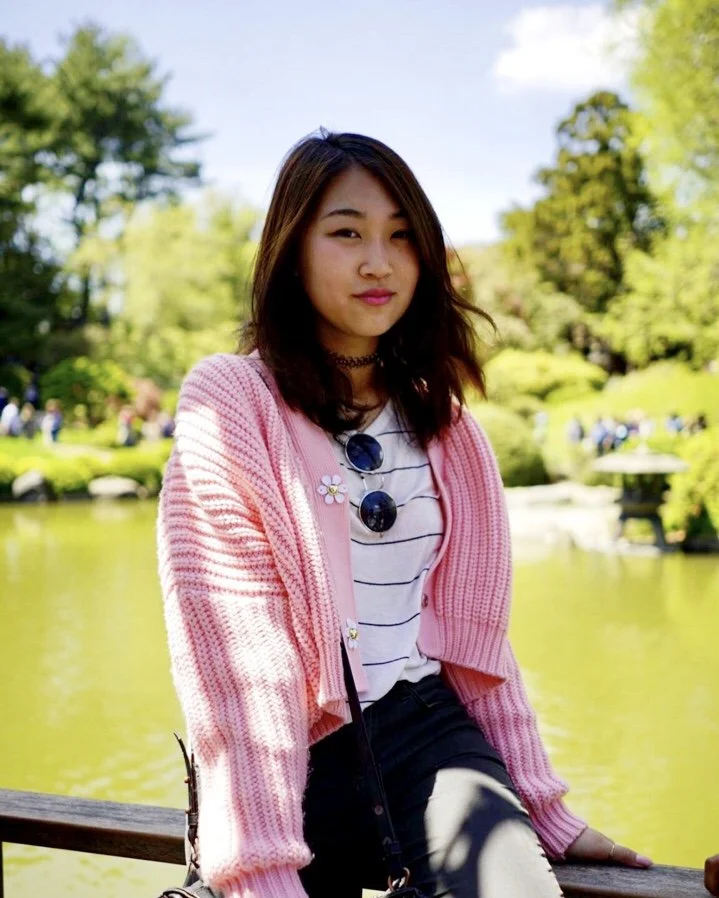10 Questions with Manami Moriyama
Manami is a technical designer and creative based in New York, originally from Japan. With a lifelong passion for fashion, she moved to the city to pursue her career and has since worked with New York-based brands specializing in contemporary clothing. Her approach blends precision and creativity, and outside of her design work, she creates fashion collages as a personal visual journal—capturing inspiration, mood, and the ever-evolving style landscape.
Manami Moriyama - Portrait
ARTIST STATEMENT
“My collages are a celebration of the hidden joys in everyday life. With each piece, I weave together fragments of moments—snapshots of places, activities, and outfits—to create a visual diary of my days or trips. Drawing inspiration from the playful spirit of scrapbooks and the nostalgic charm of Rookie Yearbook, my work emerges intuitively, like a puzzle of memories. The process is both cathartic and meditative, allowing me to piece together the fragments of time and experience. Through my collages, I hope to invite others to find beauty in the mundane and remember that even in the most ordinary moments, there’s always a spark of joy waiting to be discovered.”
— Manami Moriyama
4.13, ps, 768X1024 px, 2025 © Manami Moriyama
INTERVIEW
Let's start from the basics. Can you tell us about your journey from Japan to New York and what inspired you to pursue fashion design?
I grew up watching Disney movies and cartoon networks, and also the animated film Yellow Submarine album by the Beatles. so I think that's when I first started getting attracted to American culture. I loved how everything was super colourful and pop; it was very different from Japanese shows. So I asked my parents for clothing that's similar to what I saw in the shows because I couldn't think of any other way to resemble the vibe. Then, My mom's best friend visited our hometown in NY with her two daughters; I saw and heard them speaking in English, and they told me how it's very different in my hometown versus NY, where they grew up. It was like hearing about a movie, and it made me want to visit NY.
My family loves fashion. So fashion was a very natural part of my life growing up. I think the biggest reason why I was drawn to American and European designs more than Japanese is simply because my parents owned more of them. Levi jeans, Polo shirts, Ralph Loren Sweaters, Burberry trench, Adidas shoes, Dr Martin's boots, and not to mention classic Hein's t-shirts and tanks!
How did your studies or early experiences shape your approach to technical design?
I first studied Fashion Design. Technical design was just a part of the curriculum, where I learned detailed sketches of the construction and finishes of the garment and a more detailed fit of garments. I found it more fun to look at details and polish garments in those classes. So, I switched my major to technical design. I feel like my background and experience shapes how I work now a lot. Things I learned from school, of course, but also what I learned from my grandma's kimono tailoring, or when I have some vintage leather jacket, I always remember how my dad used to take care of them.
4.18, ps, 768X1024 px, 2025 © Manami Moriyama
3.30, ps, 768X1024 px, 2025 © Manami Moriyama
What draws you to the balance between precision and creativity in your design work?
I think precision and creativity sort of come together. Creativity sounds like something is made from scratch, but sometimes, it's about refining an existing design. When it comes to clothing, of course, the garments need to fit on the human body and have to be functional and, ideally, long-lasting. So the precision is about the shape of each panel, how it's constructed, and overall measurement.
How did your collage practice begin, and what does it offer you that fashion design doesn't?
I started it as a safe place for my creative thoughts. As much as I enjoy fashion, I sometimes feel like I'm not letting my creativity take it all the way. Maybe there is a certain rule I need to follow, or there is a pressure of failure. The collage is completely private. It allows me to separate my creativity from work and let my intrusive thoughts lead. It's almost like my inner child coming out, and somehow it makes me feel a bit nostalgic.
You describe your collages as a visual diary. What kinds of moments or moods are you most drawn to capturing?
The main focus is fun and happiness. I try to take pictures of anything that makes me feel happy, even slightly. It usually starts with my outfit. I enjoy picking out a fit, as many of us do, then when I go out, I try to snap photos of anything I see that I think is fun or interesting. The Streets of New York is the best place for this because I never know what I find on the street: Scattered flowers, perfectly fine furniture and clothes being trashed on the side, dogs riding back of motorcycles, beautiful buildings, and always interesting people.
I wanted to make sure I keep a record of fun times so I can simply look back at it. But also, it's like a personal history book and a collection of my footprints. So when I feel blue, I wanna look at the collage and remind myself who I reallyam, where I came from and what I've been through, and look forward to another fun day.
3.5, ps, 768X1024 px, 2025 © Manami Moriyama
How do you choose the materials or images that go into each collage? Is it spontaneous or planned?
It's very spontaneous. I pick a main item- usually one of my outfit selfies, then fill the canvas with related photos such as pictures taken at the same time or places. Sometimes, I throw pictures from different times or places if they feel like they belong to the same canvas. Sometimes, some canvases are cohesive, sometimes not. It's really how I feel when I build them. But I'm trying not to control too much or align the feeling of it because I want to be able to capture what I feel when I make the collage, even if it looks out of place later when I look back at it.
Rookie yearbooks and scrapbooks seem to influence your style. What other sources of inspiration feed your creative process?
It's hard not to get influenced by SNS these days. I think my base style of collage still comes from Rookie yearbooks and scrapbooks, but I feel like sometimes my outfits or places I go are what I find on Instagram.
Your work highlights joy in everyday life. How has this perspective shaped the way you see or experience the world around you?
Growing up, my mom always told me to find joy in any circumstance. It shapes my personality today, to look at the bright side of something that wasn't so pleasing, to think why something happens in a certain time or way. When something inconvenient happens, my first thought is to think what I can learn or gain from it. This built me a great tolerance, not to get stressed so easily or snap into a reaction.
3.9, ps, 768X1024 px, 2025 © Manami Moriyama
3.25, ps, 768X1024 px, 2025 © Manami Moriyama
How do your collage projects influence your fashion design practice, if at all?
I sometimes find a new way to style garments through collage. It may not be the way the garment was initially designed, but something works better for my personal style. Or it could be the other way around. I style some clothes then when I start collage, it leads to a totally different feeling at the end. Since I make my collage very spontaneously, with no mapping, I honestly don't know what I get at the end, but it's usually a good surprise.
Lastly, what are you currently working on, and are there any upcoming projects you're excited about?
I'm thinking of continuing with the collage for this whole year. I originally started to collect the last bit of my 20s, then finished with my birthday collage. But I think it'll be fun to see how it grows in a year. It could be a totally different collage at the end of this year, or maybe I will keep it the same way; I never know. It's good to see myself from an outside perspective sometimes. I'm hoping it helps me to reflect on my true self and examine my internal thoughts and feelings.
Artist’s Talk
Al-Tiba9 Interviews is a promotional platform for artists to articulate their vision and engage them with our diverse readership through a published art dialogue. The artists are interviewed by Mohamed Benhadj, the founder & curator of Al-Tiba9, to highlight their artistic careers and introduce them to the international contemporary art scene across our vast network of museums, galleries, art professionals, art dealers, collectors, and art lovers across the globe.






















